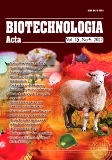ISSN 2410-7751 (Print)
ISSN 2410-776X (Online)

Biotechnologia Acta V. 15, No. 4, 2022
P. 30-33. Bibliography 8, Engl.
UDC: 616.98-055.2+616-002-008.953-092
https://doi.org/10.15407/biotech15.04.030
K. Rebenko1, 2, B. Donskoy1, L. Stamboli1
1Institute of Pediatrics, Obstetrics and Gynecology of NAMS of Ukraine, Kyiv
2Taras Shevchenko National University of Kyiv, Ukraine
COVID-19 disease, an acute respiratory infection caused by the SARS-CoV-2 virus, manifests itself in various severity forms - mild, moderate and severe, caused by the reactions of the patient's immune response.
Aim. To evaluate the serum levels of immunoglobulins G, M, and A and the number of circulating monocytes of different phenotypes in female patients with the abovementioned forms of COVID-19 severity.
Methods. Blood samples of 53 women with SARS-CoV-2 infection were studied. Flow cytofluorimetry was used to estimate monocyte subpopulations by the expression of CD14 and CD16. Concentrations of IgM, IgG, and IgA in the serum were determined in radial immunodiffusion test according to Mancini.
Results. The relative number of non-classical monocytes with CD14+-CD16++ phenotype was significantly decreased in the blood of COVID-19 patients from all 3 clinical severity groups, while changes in the number of classical and intermediate monocytes were insignificant. The levels of IgA in COVID-19 patients significantly decreased after recovery as compared to the acute phase of the infection.
Conclusion. The results emphasize the importance of monocyte subpopulation analysis in COVID-19 diagnosis and indicate dynamic changes in IgA levels depending on disease severity. The research data may help in the development of new diagnosis methods and therapy for SARS-CoV-2 infection.
Keywords: COVID-19, circulating monocytes, immunoglobulin isotypes M, G and A.
© Palladin Institute of Biochemistry of the National Academy of Sciences of Ukraine, 2022
References
1. Hu B., Guo H., Zhou P. Characteristics of SARS-CoV-2 and COVID-19. Nature Reviews Microbiology. 2021,. 19, pp. 141–154, https://doi.org/10.1038/s41579-020-00459-7
2. Wang H., Li X., Li T., Zhang S., Wang L., Wu X., Liu, J. The genetic sequence, origin, and diagnosis of SARS-CoV-2. European Journal of Clinical Microbiology & Infectious Diseases. 2020, 39(9), 1629?1635, https://doi.org/10.1007/s10096-020-03899-4
3. Rutkowska E., Kwiecie? I., K?os K., Rzepecki P., Chcia?owski A. Intermediate Monocytes with PD-L1 and CD62L Expression as a Possible Player in Active SARS-CoV-2 Infection. Viruses. 2022, 14(4), 819. https://doi.org/10.3390/v14040819
4. Wu F., Wang A., Liu M., Wang Q., Chen J., Xia S., Ling Y., Zhang Y., Xun J., Lu L., Jiang S., Lu H., Wen Y., Huang, G. Neutralizing Antibody Responses to SARS-CoV-2 in a COVID-19 Recovered Patient Cohort and Their Implications. The Lancet Infectious Diseases. 2020, D-20-01656, https://doi.org/10.1101/2020.03.30.20047365
5. Vabret N., Britton G. J., Gruber C., Hegde S., Kim J., Kuksin M., Levantovsky R., Malle L., Moreira A., Park M. D., Pia L., Risson E., Saffern M., Salom? B., Selvan M. E., Samstein M. N. Immunology of COVID-19: Current State of the Science. Immunity. 2020, 52(6), 910–41, https://doi.org/10.1016/j.immuni.2020.05.002

